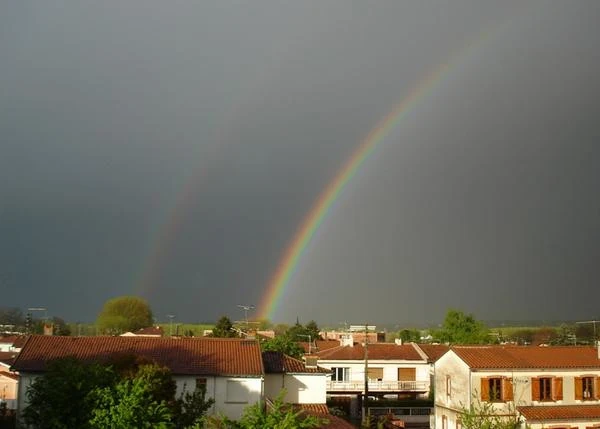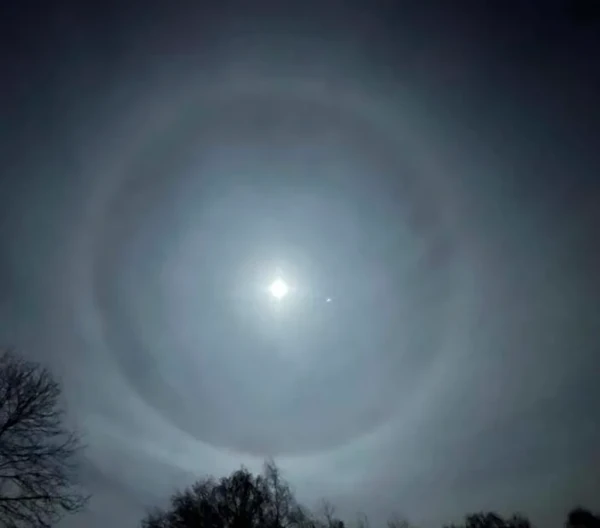
Image description: The rainbow appears as a circular arc in the sky, typically positioned opposite the Sun. The colors are arranged according to wavelength, with red on the outside and violet on the inside of the arc. The light reaching the observer's eye comes from many water droplets scattered in the air, each contributing to the formation of the rainbow. In this personal photo from 2013, a much fainter secondary arc can be seen, with its colors reversed. Source: Astronoo
The rainbow is an optical and meteorological phenomenon that manifests as a series of visible colors in the form of an arc in the sky. This phenomenon occurs mainly when the white light from the Sun is decomposed into seven colors (red, orange, yellow, green, blue, indigo, violet) as it passes through water droplets in the atmosphere.
The nature of white light emitted by the Sun is actually a mixture of all wavelengths of visible light. Each color corresponds to a specific wavelength:
• Red: approximately 620-750 nm
• Orange: approximately 590-620 nm
• Yellow: approximately 570-590 nm
• Green: approximately 495-570 nm
• Blue: approximately 450-495 nm
• Indigo: approximately 425-450 nm
• Violet: approximately 380-425 nm
The Origin of the Seven Colors: The seven colors in the rainbow were popularized by Isaac Newton (1643-1727) in the 17th century. When he conducted his experiments with a prism, he observed that white light decomposed into a spectrum of colors. Although this spectrum is continuous and the transition between colors is smooth, Newton chose to divide this spectrum into seven distinct parts, inspired by cultural and musical concepts like the seven musical notes.
Refraction: When white light (such as sunlight) enters a water droplet, it changes direction, a phenomenon known as refraction. Light travels more slowly in water than in air, resulting in a change of speed and direction of light within the water droplet.
Dispersion: White light is made up of several wavelengths, each corresponding to a different color (red, orange, yellow, green, blue, indigo, violet). Upon entering the water droplet, the different wavelengths of light are refracted at different angles due to their varying propagation speeds in water. This causes a separation of colors, a process called dispersion.
Total Internal Reflection: Once the light has been refracted and dispersed, it reaches the opposite surface of the water droplet. If the angle of incidence of the light is greater than the critical angle, the light will be completely reflected inside the droplet (total internal reflection).
Second Refraction: After being reflected, the light moves back toward the exit of the water droplet, where it undergoes a second refraction. This results in a new separation of colors, which intensifies the dispersion effect.
For a rainbow to be visible, it is necessary to have water droplets in the atmosphere, typically in the form of rain but also as fog or mist. Additionally, the Sun must be low in the sky (usually early in the morning or late in the afternoon), and the observer must be positioned between the Sun and the rain, with the Sun behind them. For a primary rainbow, the typical angle of view is about 42 degrees relative to the direction of the sun. In other words, if you imagine a line going from the sun to the observer, the rainbow forms at an angle of 42 degrees above that line.

Image description: The monochrome rainbow is a simple arc, like lunar rainbows, often fainter than colored rainbows.
There are several types of rainbows, the most well-known are:
• Primary Rainbow: The primary rainbow typically displays a spectrum of seven colors: red, orange, yellow, green, blue, indigo, and violet. It is formed by a single reflection inside water droplets.
• Secondary Rainbow: The colors of the secondary rainbow appear in the reverse order of those in the primary rainbow. They are fainter and located above the primary arc. The secondary rainbow is formed by two internal reflections.
• Monochrome Rainbow: It forms with only a single color, often under specific conditions like the light arcs that can be observed around the Moon, called lunar rainbows.